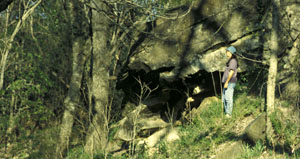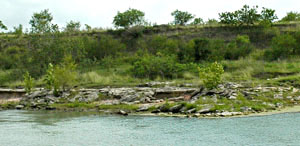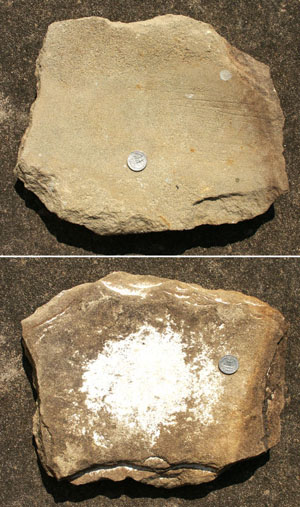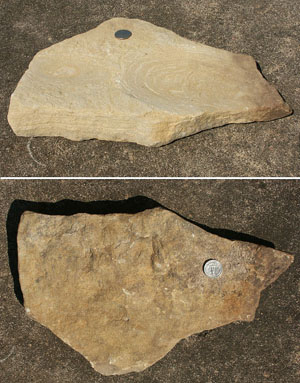Sandstone
Sandstone is an important lithic resource in the South Texas Plains and one that can be found in many different areas of the region. Standing outcrops and surface exposures occur in various of the geological formations that run from northeast to southwest across the central part of the region. At some outcrops, the sandstone is fairly hard (well cemented with silica) and quite suitable for making artifacts. Other outcrops have weakly cemented, friable sandstones (cemented by calcium carbonate) that are not suitable for making tools, but often for cooking stone. Durable pieces of sandstone are also found in cobble form in some upland gravels and in river gravel bars downstream from where the river cuts through sandstone exposures.

Outcrops of sandstone on the floodplain and terrace similar to this likely served as a source of material for hot-rock earth ovens throughout the occupational history of the Richard Beene site. |
Sandstone is a sedimentary rock type that sometimes has pronounced bedding planes – thin layers representing the original layers that were laid down by the sedimentary process by which the sand was deposited (sandbars, sand dunes, and so on). Over geological time, sand deposits are compacted by overlaying layers of rock, and then naturally cemented by crystalline minerals, such as silica and calcite, which impregnate sand deposits turning these into rock.

Outcrop of sandstone exposed by the Guadalupe River north of Victoria. Pieces of this material would be found in gravel bars just downstream. Photo by Michael R. Bever. |
Hard sandstone works well for ground-stone tools – grinding slabs and manos. The softer the sandstone, the quicker tools made from it would have worn out, but less than ideal materials were often used. Another common tool use is that of an abrader, a piece of sandstone (and other rocks such as quartzite) that has linear grooves formed by back and forth motion. Flintknappers use abraders during manufacture to dull the edges of chipped-stone artifacts, thus creating stronger platforms for flaking. Many other materials were likely abraded – shaped by grinding – including bone and wooden tools.
|
Sandstone grinding slab from McMullen County vicinity, both sides shown. This material is relatively hard and well-cemented with fairly coarse sand grains. At the top is the working surface, a slightly concave ground surface upon which nuts or seeds or other plant products were reduced to meal. Note also the linear grooves from presumably later use of this artifact for abrading. At the bottom is the natural unmodified surface which retains traces of calcium carbonate, probably from its original geological context. Brom Cooper Collection, TARL |

